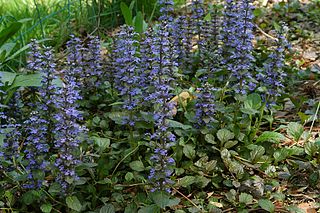
Ajuga reptans is commonly known as bugle, blue bugle, bugleherb, bugleweed, carpetweed, carpet bugleweed, and common bugle, and traditionally however less commonly as St. Lawrence plant. It is an herbaceous flowering plant in the mint family Lamiaceae, native to Europe. It is invasive in parts of North America. It is also a component of purple moor grass and rush pastures, a Biodiversity Action Plan habitat in the United Kingdom.

Calyceraceae is a plant family in the order Asterales. The natural distribution of the about sixty species belonging to this family is restricted to the southern half of South America. The species of the family resemble both the family Asteraceae and the Dipsacaceae.

Downingia bella, also known as Hoover's calicoflower or Hoover's Downingia, is a member of the Bellflower Family (Campanulaceae). The genus is named after A.J. Downing (1815–1852) a noted American horticulturist and landscape architect.

Symphyotrichum is a genus of over 100 species and naturally occurring hybrids of herbaceous annual and perennial plants in the composite family, Asteraceae, most which were formerly treated within the genus Aster. The majority are endemic to North America, but several also occur in the West Indies, Central and South America, as well as one species in eastern Eurasia. Several species have been introduced to Europe as garden specimens, most notably New England aster and New York aster.

Echinacea atrorubens, called the Topeka purple coneflower, is a North American species of flowering plant in the family Asteraceae. It is native to eastern Kansas, Oklahoma, and eastern Texas in the south-central United States. It is found growing in dry soils around limestone or sandstone outcroppings and prairies.
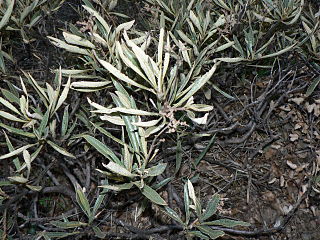
Eriodictyon is a genus of plants known by the common name yerba santa within the Hydrophylloideae subfamily of the borage family, Boraginaceae. They are distributed throughout the southwestern United States and Mexico.

Cuscuta californica is a species of dodder known by the common names chaparral dodder and California dodder. This is an annual parasitic plant that may resemble fine strands of spaghetti or twine strewn across other species in its habitat. A mature plant of this species may fulfill all of its food and water needs from the host plant, but they rarely kill their host. It is native to western United States and Baja California in Mexico.

Crinum asiaticum, commonly known as poison bulb, giant crinum lily, grand crinum lily, or spider lily, is a plant species widely planted in many warmer regions as an ornamental. It is a bulb-forming perennial producing an umbel of large, showy flowers that are prized by gardeners. However, all parts of the plant are poisonous if ingested. Some reports indicate exposure to the sap may cause skin irritation.
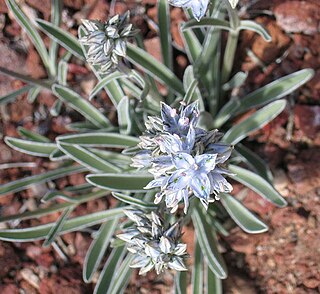
Frasera albicaulis is a species of flowering plant in the gentian family known by the common name whitestem frasera. It is native to the northwestern United States, where it grows in open areas in mountain habitat. It is a perennial herb growing from a woody base surrounded by rosettes of leaves, its stem growing 10 to 70 centimeters tall. The leaves are green with white margins. The basal leaves are lance-shaped, up to 30 centimeters long, and borne on petioles. Leaves higher on the stem are smaller and narrower and are oppositely arranged. The inflorescence is a dense panicle atop the stem, sometimes interrupted into a series of clusters of flowers. Each flower has a calyx of four pointed sepals and a corolla of four pointed lobes each one half to one centimeter long. The corolla is pale greenish white to light blue to purple, often dotted, streaked, or veined with darker blue. There are four stamens tipped with large anthers and a central ovary.

Frasera albomarginata is a species of flowering plant in the gentian family known by the common name desert green gentian, or desert frasera.
Frasera fastigiata is a species of flowering plant in the gentian family known by the common name clustered green gentian. It is native to the northwestern United States, where it grows in meadows and other mountain habitat. It is a perennial herb producing a single stem which grows erect and often exceeds a meter in height. The basal leaves have oval or spoon-shaped blades up to 30 centimeters long by 10 wide. Leaves higher on the stem may be smaller and narrower. Some of the leaves have white margins. The inflorescence is a dense panicle atop the stem, sometimes interrupted into a series of clusters of flowers. Each flower has a corolla of four pointed lobes each roughly a centimeter long. They are greenish, often tinged with yellow or blue. There are four stamens tipped with large anthers and a central ovary.
Frasera neglecta is a species of flowering plant in the gentian family known by the common name pine green gentian.
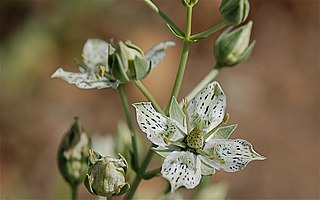
Frasera parryi is a species of flowering plant in the gentian family known by the common name Coahuila frasera.
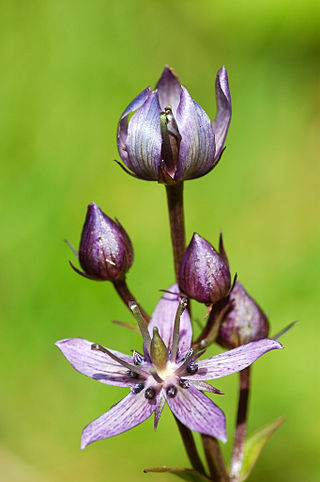
Swertia perennis is a species of flowering plant in the gentian family known by the common names felwort and star swertia. It is native to several regions of the northern hemisphere, including much of Eurasia and western North America. It is a plant of wetlands, particularly calcareous fens. It is common to abundant in many areas, but it is known to be negatively impacted by habitat fragmentation and other habitat destruction, and human activity has led to its extirpation from some areas where it was once common. It is a perennial herb producing usually one erect stem growing 10 to 50 centimeters tall. The basal leaves are spoon-shaped with rounded tips, and leaves higher on the plant are widely lance-shaped or somewhat oval, with pointed tips. The inflorescence is an open panicle of flowers atop the stem. Each flower has a calyx of four or five pointed sepals and a corolla of four or five pointed lobes each up to 1.3 centimeters long. The corolla is dull blue to violet in color with darker purplish veining or stippling. There are two rounded nectary pits at the base of each lobe of the corolla. Stamens tipped with large anthers surround a central ovary.
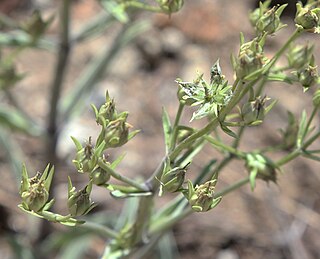
Frasera puberulenta is a species of flowering plant in the gentian family known by the common name Inyo frasera.
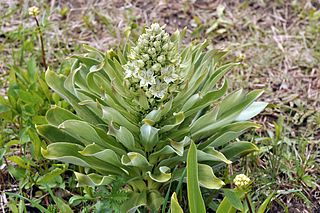
Frasera speciosa is a species of flowering plant in the gentian family (Gentianaceae) known by the common names elkweed, deer's ears, and monument plant.
Frasera tubulosa is a species of flowering plant in the gentian family known by the common name Kern frasera.
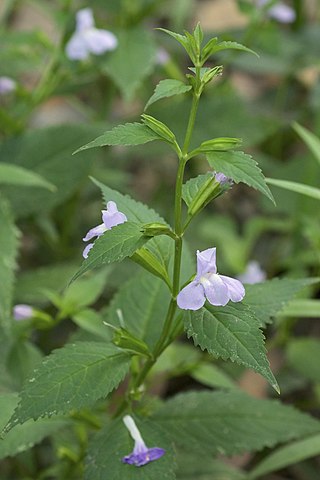
Mimulus alatus, the sharpwing monkeyflower, is an herbaceous eudicot perennial that has no floral scent. It is native to North America and its blooming season is from June to September. The flowering plant has green foliage and blue to violet flowers. It has a short life span compared to most other plants and a rapid growth rate. Like other monkey-flowers of the genus Mimulus, M. alatus grows best in wet to moist conditions and has a bilabiate corolla, meaning it is two-lipped. The arrangement of the upper and lower lip petals suggests a monkey’s face. The winged stems together with the monkey face give the plant its common name.

Chionophila tweedyi, or Tweedy's snowlover, is a perennial herb in the plantain family. It is native to Idaho and Montana in the western United States.

Goodenia watsonii is a species of flowering plant in the family Goodeniaceae and is endemic to the south-west of Western Australia. It is a perennial herb with egg-shaped to elliptic leaves mostly at the base of the plant, and thyrses of white, cream-coloured or bluish flowers.


















